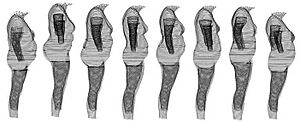Body volume index facts for kids
The Body Volume Index (BVI) is a new way to understand if someone's weight is healthy. It's being looked at as an alternative to the Body Mass Index (BMI). The BMI helps show if a person might be overweight or underweight. It uses your total weight compared to your height. But the BMI doesn't consider where your body fat is located. Recent studies show that BMI might not always be the best way to tell someone's health risk.
How the Body Volume Index (BVI) Works
The BVI was created in 2000. It uses special computer programs to check if a person is obese (has too much body fat). The BVI looks at your BMI, the size of your waist, and your waist-hip-ratio.
The BVI uses a 3D full body scanner to figure out a person's health risk. This scanner can tell the difference between people who have the same BMI but look different or carry their weight in different places. The BVI is currently being tested in hospitals in the US and Europe. A two-year study is checking if it's as helpful as the BMI.
BVI vs. BMI: How They Measure You
You can measure BMI by hand, using just a person's height and weight. The BVI, however, is calculated automatically. It uses information from a 3D scanner. The BVI doesn't just look at your total weight or total fat.
Scientists have found that fat around your stomach area, known as central obesity, can be a bigger health risk. A full body scanner creates a 3D picture of your body's outside shape. Then, a computer can figure out the size of different body parts. It also estimates how fat and weight are spread out. The BVI uses this detailed Body Composition data to guess where fat and weight are located on your body.
Most body scanners take many pictures from different angles. They use special lights and patterns on the body. This helps them figure out your body shape and where your weight is distributed.
See also
 In Spanish: Clasificación de la obesidad para niños
In Spanish: Clasificación de la obesidad para niños


